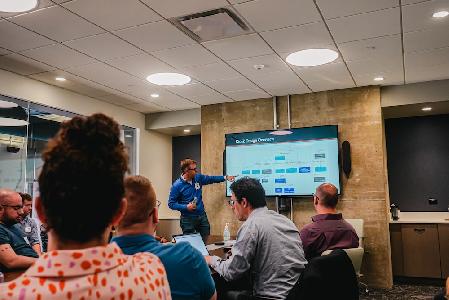
The cover of the subsequent book resulting from the Gathering Storm committee.
This story is part of a series produced by Technically Philly. It is published in support of Teach for America’s 2012 education workshop series Greater Philadelphia: Innovation in Education. The series will run daily Dec. 5-9
It was the Gathering Storm that brought Philadelphia’s science, technology, engineering and mathematics professionals interested in STEM education to action.
Known as the “Rise of the Gathering Storm” committee, in 2005, representatives of the National Academy of Sciences, National Academy of Engineering and the Institute of Medicine addressed a congressional committee on America’s ability to compete globally in the 21st century.
The committee said in its executive summary that it was “deeply concerned that the scientific and technological building blocks critical to our economic leadership are eroding at a time when many other nations are gathering strength.”
On the top of the list of actionable change was improvements to K-12 STEM education.
In part, it led to the Philadelphia Education Fund‘s launch of the Math & Science Coalition, a group of 45 partner organizations from corporate and educational industries dedicated to advancing the conversation around math and science instruction in Philadelphia public schools.
– Don McKinney
“An overwhelming majority of future jobs in the country will have some STEM component to them. The skills that STEM gives to students are absolutely essential for the future workforce,” says Math & Science Coalition President Don McKinney, who has run the program since 2006.
With STEM programming abundant across extracurricular activities and in alternative learning environments, the Math + Science Coalition raises awareness and creates opportunities to ensure that good teachers are available in public schools in Philadelphia.
As we reported earlier this week in the first two parts of this series, STEM education faces an uphill battle in the School District because of policy precedent and the summer’s budget crisis, which could affect the local workforce that is available for 21st century jobs.
Today, leaders say that in School District classrooms, success in STEM education is hurt by a disproportionate focus on math skills driven by state testing requirements, a curriculum that has difficulties impacting and interesting young students, and an inability to retain teaching talent across STEM studies.

School District of Philadelphia headquarters on North Broad St. Photo: Wikipedia
Pennsylvania System of School Assessments (PSSA) testing requires that by 2014, all public school students are proficient or better in math and reading content testing.
Leaders say that because budgets are allocated to meet these more rigorous testing requirements, a shadow is being cast upon science learning. The state’s focus on math and reading testing results in higher proficiency levels in those subjects compared to science in the School District of Philadelphia.
– Megan Doherty
In 2011, test scores for Philadelphia middle school students show that half of students have only below-basic knowledge of science content [PDF], the lowest designation of PSSA scores.
Twenty-six percent of the 8th graders that tested show proficiency or better in science content. Across the state, 58 percent of 8th graders show proficiency or better [PDF], more than double the District.
For math and reading content, 57 percent of District 8th graders show proficiency in math and 63 percent show proficiency in reading [PDF].
Joseph Merlino, President of the 21st Century Partnership for STEM Education (21PSTEM), says that because science proficiency scores do not impact Adequate Yearly Progress (AYP), which determines how schools are performing, there are no consequences for low scores, and thus less attention paid to those scores.
“If you don’t make AYP in english or math, your school gets put on a corrective action list. If it tanks in science, there’s no penalty,” he says.
The 8th grade science test scores are discouraging, considering that captivating student interest in STEM fields in elementary and middle school has a larger long-term impact than pushing students into advanced courses in high school, according to a new study from the University of Virginia.

Greater Philadelphia: Innovation in Education
Application deadline: December 16
Teach for America, in partnership with Technically Philly, will be hosting an invite-only series of education innovation workshops in 2012 intended to inspire the creation of actionable nonprofit and business ventures to impact education. TFA is looking for a cross-industry pool of applicants but is encouraging Philadelphia’s entrepreneurial technology community to get involved. Mention that you saw the workshops on Technically Philly in your application.
More Information
“Unless students are connected in math and science by the time they reach grade eight, it’s going to be almost impossible to get them interested,” says McKinney, who pointed to the research.
Many of these issues are clear to outsiders that partner with the School District across STEM activities.
Megan L. Dougherty manages an umbrella of outreach efforts at the School of Engineering and Applied Sciences at the University of Pennsylvania, which trains secondary teachers and provides research experiences for high school students.
Her day-to-day work includes creating programming for high schools that utilize Penn facilities — like its robotics and nanotechnology laboratories — and volunteer resources. The entity also helps provide resources for individual program for efforts like FIRST LEGO League, a regional youth robotics competition which is hosted locally by Penn each year.
The crux of the issue for Dougherty lies in the ultimate mission of her outreach: finding students that can be a strong fit for Penn Engineering.
Something as simple as generating a list of schools in Philadelphia that offer a competitive curriculum that includes pre-calculus and physics classes, prerequisites for the engineering program, can be difficult, she says.
“If you’re looking at it from the angle of trying to get Philadelphia students to apply to Penn Engineering, there are not that many to choose from,” she says. “They’re not going to have the background necessary.”
The student talent gap is in part widened by a shortage of quality STEM teachers, experts say, a problem not unique to Philadelphia, but also nationally.
Many school districts, like Philadelphia’s, do not require secondary certification at the middle school level in math or science to teach those classes. And teacher mobility rates — those that retire, take medical leave, or switch schools, subjects or grade levels — which leave students and training behind, impact success.
According to a forthcoming report from the 21PSTEM, which trains teachers in more than 90 schools in the region, 60 percent of math and science School District teachers leave their post every two years for those reasons listed above.

Merlino
“You have kids with an unstable urban district. Some have an unstable family life, as well. Combine all this swirling and now you want them to learn?” asks Merlino.
“It’s an impediment to doing anything regarding science, technology engineering and mathematics,” he says. “Even if you have infrastructure, you need to stabilize the workforce.
Hurdles in Philadelphia public schools also stretch beyond the classroom.
Students that participate in extracurricular STEM activities at least a few times a year are 50 percent more likely to follow a STEM-related career path, according to a University of Virginia report issued last month.
But teachers that coordinate extracurricular STEM opportunities for their students must jump through hoops because of liability issues, limited access to transportation, and uncertain funding constraints for extracurricular pay as a result of the District’s summer budget crisis.
It’s simply easier to work locally with charter programs, Dougherty says, where there is often more resources and more flexibility.
More and more, concerned stakeholders are looking at solutions adjacent to and outside the District to fix the problem.
READ THE ENTIRE ‘STATE OF STEM’ SERIES
Part 1 of this series: STEM graduation rates show uphill battle with math and science in School District
Part 2 of this series: Lack of citywide STEM education vision leaves Philly’s skilled workforce in jeopardy
Part 3 of this series: State and District math and science policies leave gaps in competitive STEM curriculum
Part 4 of this series: Citizens work alongside the school system to strengthen District STEM

Join the conversation!
Find news, events, jobs and people who share your interests on Technical.ly's open community Slack

Philly daily roundup: Student-made college cost app; Central High is robotics world champ; Internet subsidy expiration looms

Philly daily roundup: Earth Day glossary; Gen AI's energy cost; Biotech incubator in Horsham

Philly daily roundup: Women's health startup wins pitch; $204M for internet access; 'GamingWalls' for sports venues
